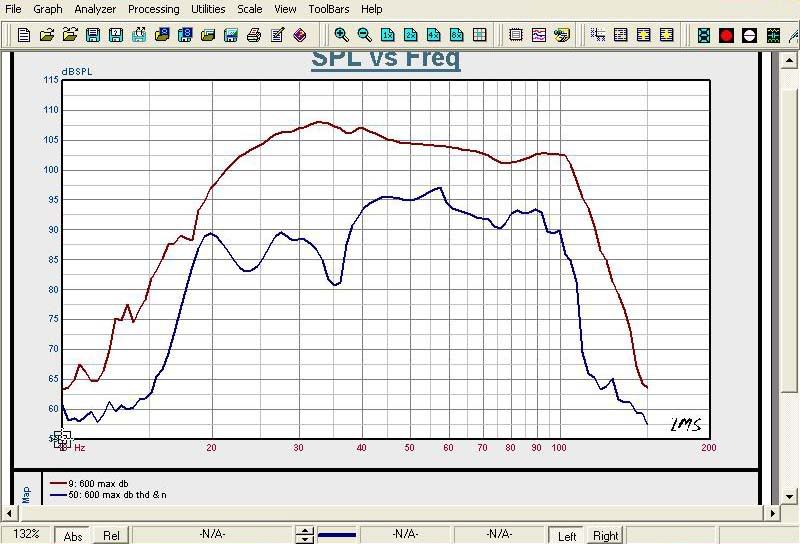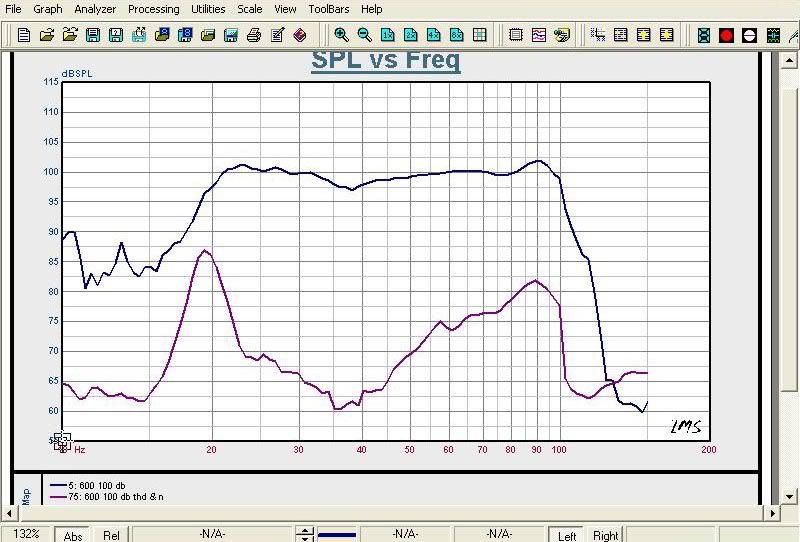 Re: Texas' New Epicenter
|
Joined: Oct 2006
Posts: 280
local
|

local
Joined: Oct 2006
Posts: 280 |
I found that the "Flat-Half-Full" settings made a big difference in attaining a punchier bass with my EP-500 in a 20x18x8 room. Flat is intended for large rooms, whereas "Half" and "Full" are intended for medium- and small-sized rooms, although no measurements are provided for reference. With proper placement, "Full" setting, and manual tweaking with the SMS-1, I was able to hear that well-defined and punchier bass from the EP-500. For music, nevertheless, I do get "better" bass performance with the M80s connected to the A1400-8 at full-range, and the EP-500 off.
John
Last edited by ihifi; 04/20/08 06:37 PM.
|
|
|
 Re: Texas' New Epicenter
|
Joined: Aug 2007
Posts: 3,488 Likes: 9
connoisseur
|

connoisseur
Joined: Aug 2007
Posts: 3,488 Likes: 9 |
It is in their specs. 111db anachoic and 122db in room.
See Mojo's signature
|
|
|
 Re: Texas' New Epicenter
|
Joined: Mar 2008
Posts: 1,378
connoisseur
|

connoisseur
Joined: Mar 2008
Posts: 1,378 |
The full setting and use of the BFD worked for me as well with the EP500's.
LFR1100 Actives,QS10HPx2,QS8x2,EP800,M3x4,M3x2 (Wood),M5HPx2 (Wood),AxiomAir,ADA1500-8,ADA1500-7
|
|
|
 Re: Texas' New Epicenter
|
Joined: Jan 2004
Posts: 13,851 Likes: 15
shareholder in the making
|

shareholder in the making
Joined: Jan 2004
Posts: 13,851 Likes: 15 |
I agree, I'm not the one doubting the spec, and I'm sure Ian would not allow false statements on the products page, they do thorough lab testing before introducing a product.
Jason, I would carefully remove the allen screws on the driver and/or amp to make sure the wire terminals aren't bouncing around on the port. My first 500, the cables were to long and rattling on the port when I hit around 25hz with the real traps tones.
M80s VP180 4xM22ow 4xM3ic EP600 2xEP350
AnthemAVM60 Outlaw7700 EmoA500 Epson5040UB FluanceRT85
|
|
|
 Re: Texas' New Epicenter
|
Joined: Oct 2005
Posts: 853
aficionado
|

aficionado
Joined: Oct 2005
Posts: 853 |
The difference is whether or not you are looking at in-room or anechoic response. The marketing literature spec of 122db includes room gain that can add 11-14db to the anechoic response. To keep distortion in check the DSP limits output at those max levels.
At max output near 108db anechoic, and just before the limiter kicks in, distortion is fairly high at -10db down from the fundamental from 45-100hz. Also at max. output, in the 20-40hz zone distortion is around -20db down. As you back off max output to say 100db or 112db in room, distortion falls off dramatically to around -35db down from the fundamental. 112db in room is very loud.
John
|
|
|
 Re: Texas' New Epicenter
|
Joined: Oct 2005
Posts: 853
aficionado
|

aficionado
Joined: Oct 2005
Posts: 853 |
Very informative post jakeman. What are your thoughts of raising the sub xo if you have dual subs in the front corners? I would think it would be okay because, although the subs are now outputting a frequency that could be localized, since they are in the corners equidistant, it would still keep the soundstage balanced. Also, you would not be relying on a weaker amp to drive the low frequencies.
I tried xo's from 40-150, and the best response I got with 2 EP500's in the front corners was 90Hz in the AVR, subs in bypass. Good stuff, SRoode. My first recommendation is always to use dual subs because many of the issues we have been discussing disappear. I ran dual EP600s the same way for a year adjacent to the front speakers both in mono and stereo mode crossed at 90 and 100hz to a pair of monitors. The integration and soundstage was breathtaking. I always felt one of the strengths of the EP subs was their superior ability to play music compared to most other vented subs but that presumes proper setup and speaker integration. Plucky string bass and snappy snare and kick drum is what made the EP500 stand out in early blind listening tests with other noteable subs. No question that a higher crossover makes the speaker amp more efficient and preserves headroom. That alone may make it a necessity for the folks who rely on receivers. But for those with amppower to spare, lower crossover points usually means better fidelity if you have capable speakers like the M80/60s. The other reason I like lower crossovers with single or dual mono subs is you lesson the clash of upper harmonics in music between the sub and the speakers. For HT its not such a concern. Its an interesting paradox. For better phase integration and soundstage, which is so important for music, the subs almost always work best up front next to the speakers. The Harman paper advocates mid sidewall for dual subs for superior FR but makes no mention of the greater phase issues associated with such a placement. I suppose its for that reason that some designers suggest one sub up front and one in the back of the room 180 degrees out of phase when using dual mono subs. The idea is that way you get more uniform FR and maintain time alignment within the sub/sat system.
John
|
|
|
 Re: Texas' New Epicenter
|
Joined: Jan 2007
Posts: 10,515 Likes: 117
shareholder in the making
|

shareholder in the making
Joined: Jan 2007
Posts: 10,515 Likes: 117 |
I'm looking at my notes and the loudest I could get the 600 to go in my room was 110dB. That was with a 20Hz pure tone which caused significant port-chuffing and a sharp sound coming from the cabinet. The beaver helped with that sharp sound  . Now remember that I have a 4,000 cubic foot A/V space and the room is open to the rest of the house via a stairway. In smaller rooms, 122 dB is likely but, like jakeman said, certainly not distortion-free.
House of the Rising Sone
Out in the mid or far field
Linearity and mid-woofers are over-rated
|
|
|
 Re: Texas' New Epicenter
|
Joined: Oct 2005
Posts: 853
aficionado
|

aficionado
Joined: Oct 2005
Posts: 853 |
That's a pretty accurate reading.  The 20hz anechoic measurement I have is 98db at max output with the limiter kicking in. That corresponds to around 110db in room. According to these measurements, peak output is being DSP limited in 33hz zone at around 107db. All these numbers are consistent. Axioms numbers show peak output at slightly more at around 111db before the limiter, which would be more indicative than this one graphical measurement. The first graph shows what's happening at max output near 107db anechoic just as the DSP curtails things. Interestingly the THD while high doesn't sound offensive since most of it is second order. Comparatively speaking much lower amounts of odd order THD sound worse, edgy and irritating. In any event its low enough as to not be audible though it gives the EP subs that pleasant "fuller" or "thicker" sound. The second graph is with anechoic output at 100db with THD well out of the audible area. Note that even at max output the EP sub is maintaining a reasonably linear FR albeit at the cost of rapidly increasing THD. Where the DSP works is magic is to limit output at a very high level just before distortion becomes noticeable.  
John
|
|
|
 Re: Texas' New Epicenter
|
Joined: Jan 2007
Posts: 10,515 Likes: 117
shareholder in the making
|

shareholder in the making
Joined: Jan 2007
Posts: 10,515 Likes: 117 |
Right. The THD, even though I know it's there, is not objectionable except at around 20Hz where I can clerly hear chuffing. In real-world listening situations, this chuffing doesn't even enter into the equation. Once in a while, I'll be able to locate the sub during a movie explosion but this is no big deal.
BTW, these graphs show output below 16Hz. My 600 is totally silent below 16Hz. I can hear 16Hz (or artifacts thereof) but at 15Hz there's nothing.
House of the Rising Sone
Out in the mid or far field
Linearity and mid-woofers are over-rated
|
|
|
 Re: Texas' New Epicenter
|
Joined: Oct 2005
Posts: 853
aficionado
|

aficionado
Joined: Oct 2005
Posts: 853 |
I can't hear much of anything below 22hz though I can "sense" vibrations or what some writers would attribute to our ability to sense changes in the pressure gradient of the wavefront. Yes that data below 16hz is abnormal, likely caused by windnoise. Chuffing sucks because it makes higher frequency noise.  Its the achilles heal of all ported subs and the main reason I also own several sealed subs. While ported subs have higher output there is a price for everything. Output below 22hz is contributed by the port not the driver so it can be noticeable at loud volumes down low. Still, the large single flared vortex port in the EP500/600 produces much less noise than the chuffing generated by subs with tri-port or slot port designs.
John
|
|
|
|
Forums16
Topics24,994
Posts442,753
Members15,649
| |
Most Online2,699
Aug 8th, 2024
|
|
|
0 members (),
621
guests, and
1
robot. |
|
Key:
Admin,
Global Mod,
Mod
|
|
|
|



